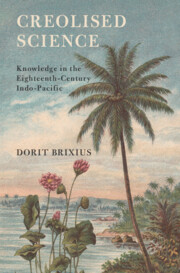Book contents
- Creolised Science
- Science in History
- Creolised Science
- Copyright page
- Dedication
- Contents
- Figures
- Acknowledgements
- Author’s Note
- Abbreviations
- Introduction
- 1 The Limits of French Colonial Visions and Science
- 2 The Acquisition of Knowledge and Plants, from Madagascar to China
- 3 Agriculture and Everyday Knowledge
- 4 Enslaved People as Knowledge Carriers
- 5 The Cross-Cultural Quest for Spices in South East Asia
- 6 Materials, Environment, and the Application of Knowledge
- Conclusion
- Bibliography
- Index
2 - The Acquisition of Knowledge and Plants, from Madagascar to China
Published online by Cambridge University Press: 03 April 2024
- Creolised Science
- Science in History
- Creolised Science
- Copyright page
- Dedication
- Contents
- Figures
- Acknowledgements
- Author’s Note
- Abbreviations
- Introduction
- 1 The Limits of French Colonial Visions and Science
- 2 The Acquisition of Knowledge and Plants, from Madagascar to China
- 3 Agriculture and Everyday Knowledge
- 4 Enslaved People as Knowledge Carriers
- 5 The Cross-Cultural Quest for Spices in South East Asia
- 6 Materials, Environment, and the Application of Knowledge
- Conclusion
- Bibliography
- Index
Summary
Chapter 2 examines the ways in which French botanists obtained information about plant cultivation. It sheds light on the exploration and collection of plants and related knowledge about them, which was made possible with the assistance of local populations in Madagascar and East Asia. It develops an argument against the prevailing historical myth the eighteenth-century naturalists were only interested in classification. The focus of the chapter is on utility and especially how useful knowledge might be communicated to French naturalists. Mauritius’s intendant’s plan to domesticate staple crops could only be conducted because of multidirectional and multinational networks consisting of French, non-French, and above all non-European assistance. These actors used several types of plant knowledge, communication systems, languages, negotiation practices, often leading to cultural misunderstandings. The chapter highlights the significance of knowing a plant’s native/local name, so that Europeans could return and access that same plant again. Here, European naturalists followed a twofold strategy to document and interpret knowledge. Exploring these details neglected in grand narratives of colonial science challenges Eurocentric narratives, the presumed superiority of European science, and the centralisation on the Parisian acclimatisation garden in particular.
Keywords
- Type
- Chapter
- Information
- Creolised ScienceKnowledge in the Eighteenth-Century Indo-Pacific, pp. 51 - 79Publisher: Cambridge University PressPrint publication year: 2024

